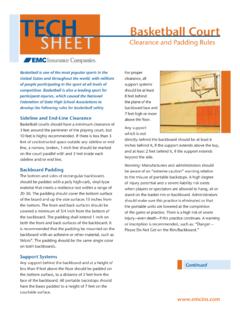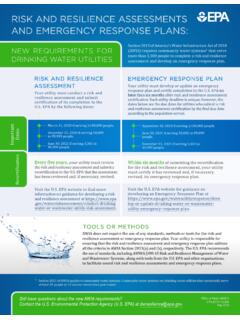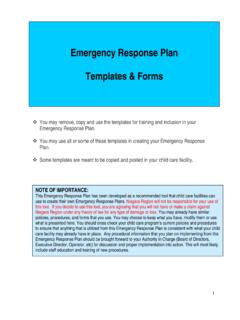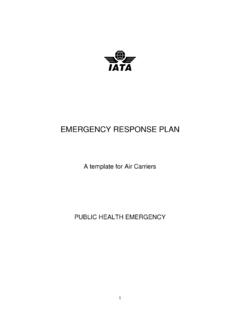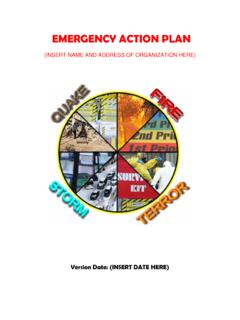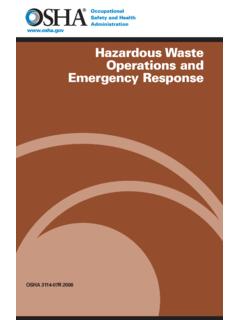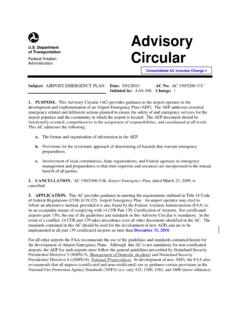Transcription of Preparing for Emergency Drills and Exercises - EMC Ins
1 Preparing forEmergency Drills and ExercisesStep 1: Develop Emergency PlansDrills and Exercises test an organization s written Emergency plan . Do not hold a drill or exercise until you have: A comprehensive Emergency /crisis master plan Position-specifi c Emergency response guides for employees with critical roles Emergency quick response guidesSince it is virtually impossible to identify and plan for every possible or potential hazard that could impact your business, Emergency plans should be response -based instead of hazard-based. This means the Emergency plans should be based on the actions you want your employees and visitors to perform regardless of the Emergency . These 10 responses will cover 99% of all the emergencies an organization may face: 1. Evacuation2. Reverse evacuation3. Lock out4. Lock down5. Clear the hallsYour organization s comprehensive Emergency /crisis master plan should include variations on each of these 10 responses based on site-specifi c hazards and explain when each response is necessary.
2 Preparing for Emergency Drills and ExercisesWhen organizations rush into performing Emergency Exercises , they often encounter the following problems: Exercises are conducted without any defi ned objectives Scenarios are too complex to manage successfully Inadequate time is allotted for exercise interaction An accurate critique of the exercise is not completed afterwards Emotional impact on the participants is not considered Safety of participants is not addressed properly Exercise is planned and initiated too quickly Some critical agencies are not included After-action recommendations are not implementedCOMMON EXERCISE MISTAKESE mergency Drills and practice Exercises are important for Preparing for Emergency situations. Unfortunately, many organizations and local Emergency responders aren t ready to conduct these events. An organization should follow these six steps to successfully conduct Emergency Drills and Exercises :1.
3 Develop Emergency plans2. Train employees3. Conduct tabletop exercises4. Conduct drills5. Conduct functional exercises6. Conduct full-scale Exercises 6. Shelter-in-place 7. Medical Emergency 8. Closing or cancelation 9. Death10. Vehicle accidentAn organization may evacuate for reasons such as fi re, a gas leak or lack of power. The master plan should detail the organization s response and recovery for each of these hazards, but the immediate response by all employees and visitors is to safely evacuate the building and, if necessary, seek safety at another location. EVACUATION EXAMPLEStep 2: Train All EmployeesAll employees should be trained at least annually on the Emergency response plans and guides and on their roles within the plans. All plans should be shared with your local Emergency responders, but not made publicly 3: Conduct Tabletop ExercisesTabletop Exercises allow organizations to test their Emergency plans and individuals knowledge of their roles and responsibilities using hypothetical situations, without causing disruption to the business day.
4 These Exercises should be very limited in scope, covering a specifi c aspect of your Emergency crisis plan . Tabletop Exercises are similar to a scenario-based board game. The facilitator presents a scenario to the players around the table, who verbally respond what actions they would take, based on the available information. Additional information is provided to the players over the course of the exercise, similar to the way new information emerges during real Emergency events. The group must adjust and respond as the new information becomes available. A recorder makes notes of items that need to be changed or added to the plan , based on the responses and other suggestions for improvement verbalized during the event. These Exercises usually last between one and two hours. Successful tabletop Exercises help identify weak points in your Emergency plan and employee training so you can address it as necessary.
5 It is much better to fi nd out your limitations in a controlled environment than during an actual Exercises are a continual process. Even when you believe your plans are well tested, you should continue to hold tabletop Exercises at least annually to help employees retain knowledge about their roles. You should also conduct tabletop Exercises after you make employee changes, building changes, equipment changes or after you adjust your Emergency 4: Conduct DrillsMany organizations already conduct Drills during the year, including those for fi re and tornados, but conducting other Emergency Drills is just as important, even if not mandated. Emergency Drills for responses such as lockdown, shelter-in-place or employee injury provide the training and route memorization of the skill sets necessary for Emergency Emergency Drills should be highly controlled, test a single procedure and involve all employees.
6 Drills should be unannounced and performed under varying and nonideal conditions ( , different times of day, different weather conditions, different times during the year or during absence of key personnel). All employees should be trained prior to any drill to make sure they know what is expected. Invite local Emergency responders to observe the people involved in your tabletop exercise will vary depending on which section of your Emergency plan you are testing. When you fi rst facilitate tabletop Exercises , it s helpful to include only a small group of employees, adding local Emergency responders later in the process. Example participants may include: Management Employees Maintenance staff Transportation staff Safety/Security personnel Fire department/EMS Law enforcement Emergency management Crisis team members NurseTABLETOP EXERCISE PLAYERSL earn MoreTo learn more about Emergency Drills and Exercises , contact your independent insurance agent, your local EMC loss control representative or email Copyright 2014 Employers Mutual Casualty Company | HelloStep 5: Conduct Functional ExercisesAfter you have performed a number of Drills for specifi c procedures, the next step is functional Exercises .
7 These Exercises help you understand how your Emergency plans integrate with local Emergency responders plans, how your incident command structure operates and how you communicate with Emergency responders during an Emergency . Functional Exercises : Are scenario-based, like tabletop Exercises , but conducted in a realistic, real-time environment without actual movement of personnel and equipment Involve all areas/departments of the organization and likely all departments of the local Emergency responders Are often conducted in several different rooms or buildings to reveal communication needs and to provide a more realistic disconnect between the organization and the Emergency responders Must be highly managed and well organized to produce useful results Must be extensively planned and require advanced notifi cationEXITStep 6: Conduct Full-Scale ExercisesA full-scale exercise is a complex, multiagency, multijurisdictional, multiorganizational exercise designed to validate many facets of Emergency plans and preparedness.
8 They not only test the organization s Emergency plans, but also the plans of the responding agencies. Very few organizations ever perform this type of exercise due to time requirements (six to eight months of planning), coordination and expense involved. Full-scale Exercises are conducted in real time, creating a stressful, time-constrained environment that closely mirrors real events in a safe manner. This may include simulated building damage, human casualties, active search and rescue, mass transportation and other activities, depending on the reporting allows you to discuss, evaluate and document the results of Drills and tabletop, functional or full-scale Exercises . This helps analyze the Emergency plans and participants performances and provides corrective actions for areas identifi ed for improvement. This is an important part of any exercise and should not be overlooked. The goal of the previously discussed Exercises cannot be achieved until the recommendations from the after-action reporting process are REPORTINGAn improvement plan serves as the roadmap to making changes, additions and deletions to your Emergency plan or training.
9 Use the after-action report to establish an improvement plan . Make sure the plan sets specifi c goals and assigns tasks with clear, specifi c deadlines to the appropriate personnel. No matter what Drills or Exercises you conduct, plans should be reviewed annually, at a minimum and revised as plan




